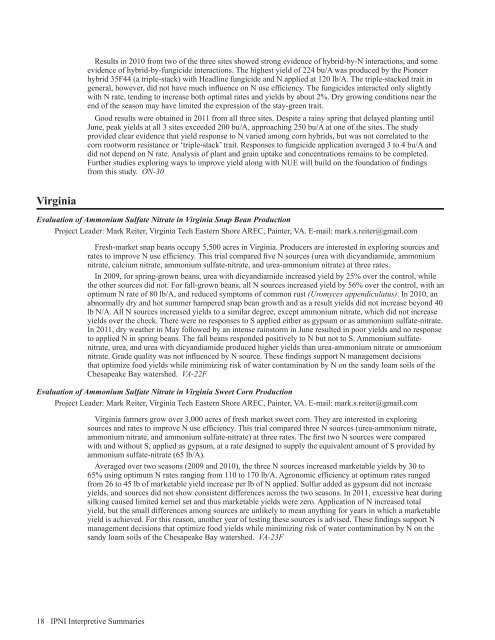Americas and Oceania Group - International Plant Nutrition Institute
Americas and Oceania Group - International Plant Nutrition Institute
Americas and Oceania Group - International Plant Nutrition Institute
Create successful ePaper yourself
Turn your PDF publications into a flip-book with our unique Google optimized e-Paper software.
Results in 2010 from two of the three sites showed strong evidence of hybrid-by-N interactions, <strong>and</strong> some<br />
evidence of hybrid-by-fungicide interactions. The highest yield of 224 bu/A was produced by the Pioneer<br />
hybrid 35F44 (a triple-stack) with Headline fungicide <strong>and</strong> N applied at 120 lb/A. The triple-stacked trait in<br />
general, however, did not have much influence on N use efficiency. The fungicides interacted only slightly<br />
with N rate, tending to increase both optimal rates <strong>and</strong> yields by about 2%. Dry growing conditions near the<br />
end of the season may have limited the expression of the stay-green trait.<br />
Good results were obtained in 2011 from all three sites. Despite a rainy spring that delayed planting until<br />
June, peak yields at all 3 sites exceeded 200 bu/A, approaching 250 bu/A at one of the sites. The study<br />
provided clear evidence that yield response to N varied among corn hybrids, but was not correlated to the<br />
corn rootworm resistance or ‘triple-stack’ trait. Responses to fungicide application averaged 3 to 4 bu/A <strong>and</strong><br />
did not depend on N rate. Analysis of plant <strong>and</strong> grain uptake <strong>and</strong> concentrations remains to be completed.<br />
Further studies exploring ways to improve yield along with NUE will build on the foundation of findings<br />
from this study. ON-30<br />
Virginia<br />
Evaluation of Ammonium Sulfate Nitrate in Virginia Snap Bean Production<br />
Project Leader: Mark Reiter, Virginia Tech Eastern Shore AREC, Painter, VA. E-mail: mark.s.reiter@gmail.com<br />
Fresh-market snap beans occupy 5,500 acres in Virginia. Producers are interested in exploring sources <strong>and</strong><br />
rates to improve N use efficiency. This trial compared five N sources (urea with dicy<strong>and</strong>iamide, ammonium<br />
nitrate, calcium nitrate, ammonium sulfate-nitrate, <strong>and</strong> urea-ammonium nitrate) at three rates.<br />
In 2009, for spring-grown beans, urea with dicy<strong>and</strong>iamide increased yield by 25% over the control, while<br />
the other sources did not. For fall-grown beans, all N sources increased yield by 56% over the control, with an<br />
optimum N rate of 80 lb/A, <strong>and</strong> reduced symptoms of common rust (Uromyces appendiculatus). In 2010, an<br />
abnormally dry <strong>and</strong> hot summer hampered snap bean growth <strong>and</strong> as a result yields did not increase beyond 40<br />
lb N/A. All N sources increased yields to a similar degree, except ammonium nitrate, which did not increase<br />
yields over the check. There were no responses to S applied either as gypsum or as ammonium sulfate-nitrate.<br />
In 2011, dry weather in May followed by an intense rainstorm in June resulted in poor yields <strong>and</strong> no response<br />
to applied N in spring beans. The fall beans responded positively to N but not to S. Ammonium sulfatenitrate,<br />
urea, <strong>and</strong> urea with dicy<strong>and</strong>iamide produced higher yields than urea-ammonium nitrate or ammonium<br />
nitrate. Grade quality was not influenced by N source. These findings support N management decisions<br />
that optimize food yields while minimizing risk of water contamination by N on the s<strong>and</strong>y loam soils of the<br />
Chesapeake Bay watershed. VA-22F<br />
Evaluation of Ammonium Sulfate Nitrate in Virginia Sweet Corn Production<br />
Project Leader: Mark Reiter, Virginia Tech Eastern Shore AREC, Painter, VA. E-mail: mark.s.reiter@gmail.com<br />
Virginia farmers grow over 3,000 acres of fresh market sweet corn. They are interested in exploring<br />
sources <strong>and</strong> rates to improve N use efficiency. This trial compared three N sources (urea-ammonium nitrate,<br />
ammonium nitrate, <strong>and</strong> ammonium sulfate-nitrate) at three rates. The first two N sources were compared<br />
with <strong>and</strong> without S, applied as gypsum, at a rate designed to supply the equivalent amount of S provided by<br />
ammonium sulfate-nitrate (65 lb/A).<br />
Averaged over two seasons (2009 <strong>and</strong> 2010), the three N sources increased marketable yields by 30 to<br />
65% using optimum N rates ranging from 110 to 170 lb/A. Agronomic efficiency at optimum rates ranged<br />
from 26 to 45 lb of marketable yield increase per lb of N applied. Sulfur added as gypsum did not increase<br />
yields, <strong>and</strong> sources did not show consistent differences across the two seasons. In 2011, excessive heat during<br />
silking caused limited kernel set <strong>and</strong> thus marketable yields were zero. Application of N increased total<br />
yield, but the small differences among sources are unlikely to mean anything for years in which a marketable<br />
yield is achieved. For this reason, another year of testing these sources is advised. These findings support N<br />
management decisions that optimize food yields while minimizing risk of water contamination by N on the<br />
s<strong>and</strong>y loam soils of the Chesapeake Bay watershed. VA-23F<br />
18 IPNI Interpretive Summaries

















